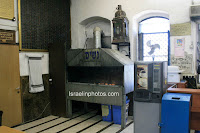The court, where the tombs of Rabbi Shimon Bar Yochai and his son Eleazar are located, was built by Abraham ben Mordechai Galante in the second half of the sixteenth century at the slope of mountain Meron. Further up the mountain is one of the oldest Galilean synagogues, Khirbet Shema, built in the third century. In this synagogue a fixed shrine for Torah Scrolls is built into the wall, while most of the synagogues of this period were equipped with mobile arks.
Many Jewish philosophers are buried at Meron. Among them is Rabbi Hillel (first century CE), whose liberal teachings are the inspiration behind many of the rabbinical decisions in our time. His cave-tomb is reached by a path leading down to the valley. Rabbi Shammai, a contemporary of Hillel, is believed to be buried in the massive double sarcophagus set on the hill facing Hillel's tomb.
Rabbi Shimon was a “fifth-generation” Tanna (author of Mishnah; †170CE). He was one of the five disciples of Rabbi Akiva who survived the massacre which followed the failure of the Second Revolt in 135CE, and a contemporary of Rabbi Shimon ben Gamliel II, who was the Nasi, the Scholar-President.
His father was a highly honored man among the Jewish people. Yochai was a pacifist; he was well-liked by the Romans and was a bitter opponent of the revolt against Rome led by Rabbi Akiva and Bar Kochba.
The Romans had made it illegal to study the Torah. Rabbi Shimon spoke out publicly against this injustice and so was sentenced to death. He and his son therefore took refuge in a cave where they lived on well water and the fruit of the carob tree. There they remained for thirteen years, studying the Torah together, both the Revealed and the Hidden Torah. Rabbi Shimon wrote down the latter material for the first time in a book called the “Zohar". [Rabbi Moses Ben Shem-Tov de Leon (1250-1305), also known simply as Moses de Leon, was a Spanish rabbi who is thought of as the author of the Zohar. It is not clear if the Zohar is his own work, or he documented and wrote down the texts that originate from the works by Rabbi Shimon bar Yochai].
The "Zohar" (or Book of Splendour) is the main book of the Kabbalists. It is a mystical commentary on the Five Books of Moses and it proceeds from the presumption that every letter, word and line in the scriptures is significant and that they contain a higher mystical meaning and an offering of the key of life.
The rabbis flocked to Zefat vicinity. They studied, taught, and published books and poems, inspired by the opening of the country's first Hebrew printing press in Zefat in 1563.
The 33rd day after Passover is called Lag BaOmer (Lamed Gimel =33). It is the day when Jews glorify Rabbi Shimon Bar Yochai on Mt. Meron (the highest mountain in Israel near the city of Zefat). On this day the celebrations are arranged in honor of Rabbi Shimon and of the revelation of the esoteric soul of the Torah.
Between Passover and Shavuot a plague raged amongst the disciples of the great philosopher Rabbi Akiva "because they did not act respectfully towards each other" (from The Laws of the Counting of the Omer). These weeks are therefore observed as a period of mourning with various joyous activities prohibited by law and custom. Lag BaOmer also carries the theme of Ahavat Yisrael, the imperative to love and respect one's fellow citizen.
Lag BaOmer traditions:
• Bonfire parties of many types. Throughout the country children collect wood for the bonfires.
• Family barbecues and Torah study over the fire are being held across the land of Israel, the largest celebration being on Mt. Meron in Zefat at the site of Rabbi Shimon bar Yochai's and his son Rabbi Eleazar’s tomb.
• Hunting bows and arrows for children. The folklore tells that Rabbi Akiva and his students, when confronted by a Roman law against Torah-study at penalty of death, would dress up for hunting and head into the forest to study. So some give children tiny bow and arrows sets with suction cups and recounting this tale about the courage it sometimes takes to study the Torah.
• Upsherin. On Lag BaOmer thousands of parents bring their three year olds for a first haircut to Mt. Meron or to the graves of other mystical philosophers.



